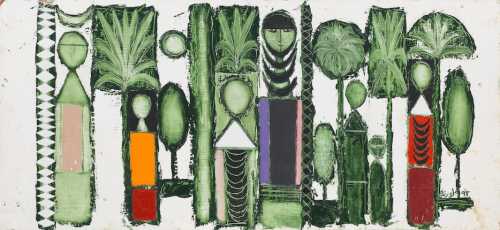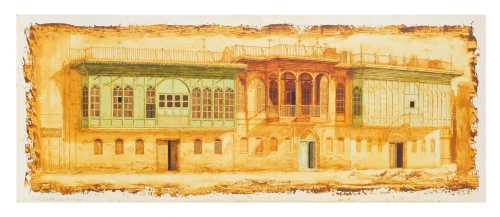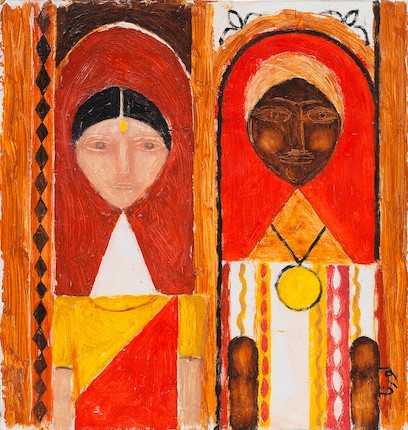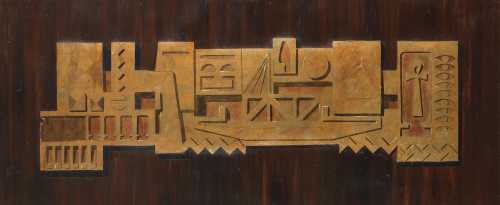- Old Houses in Karkh 1965
- oil on board
- Painting
- 111 * 29.2 cm
- signed and dated in Arabic (lower right)
20 October 2021
Estimation
£3,000
4,145 USD
-
£4,000
5,526 USD
Realized Price
£10,625
14,679 USD
203.571%
Artwork Description
Of all artists within the Baghdad Group for Modern Art, Lorna Selim remains the closest linked to the architecture of Baghdad. Born in Sheffield in 1928, Lorna was the wife of Jewad Selim, the two met while studying at Slade School of Fine Art, London in the 1940s. In 1948, Lorna moved to Baghdad with Jewad, impressed by the earthy tones and the marketplaces. As one critic stated 'Lorna came to our country and found the beauty where noone of the rest of us had noticed it before. Other artists began to study the rich artistic tradition which had been under their noses all along. She had a profound influence.' (Butters 2011) Recognised as a leading artist within the modern circles, Lorna was also integral to realising Jewad's Freedom Monument, a bronze relief mural in central Baghdad commemorating Iraq’s 1958 revolution.
While Lorna's earlier period focused on forms inspired by Faeq Hassan's paintings and Jewad Selim's compositions, her transition towards architectural renderings depicted in the present two works began in 1962 following Jewad Selim's death. Iraqi architect Mohammed Makiya offered Lorna a position at the architecture department of the College of Engineering at Baghdad University, becoming the first department to teach architecture in Iraq. Makiya invited Lorna to teach landscape painting as a way to preserve the architecture of the city. Both Makiya and Lorna would take students to the streets of Baghdad set with tasks to produce sketches and photograph the buildings.
Focusing specifically on the intricate details of the buildings, Lorna sketched with accurate precision the latticework of the doors, windows and overall structures of the buildings. Most of her depictions lay in nineteeth century Baghdadi houses along the Tigris River that contained special windows and balconies known as shanasheel. In addition to houses, Lorna would also depict domes and minarets that became a central focus in her paintings and became a panoramic view of the city centres.
While Lorna's earlier period focused on forms inspired by Faeq Hassan's paintings and Jewad Selim's compositions, her transition towards architectural renderings depicted in the present two works began in 1962 following Jewad Selim's death. Iraqi architect Mohammed Makiya offered Lorna a position at the architecture department of the College of Engineering at Baghdad University, becoming the first department to teach architecture in Iraq. Makiya invited Lorna to teach landscape painting as a way to preserve the architecture of the city. Both Makiya and Lorna would take students to the streets of Baghdad set with tasks to produce sketches and photograph the buildings.
Focusing specifically on the intricate details of the buildings, Lorna sketched with accurate precision the latticework of the doors, windows and overall structures of the buildings. Most of her depictions lay in nineteeth century Baghdadi houses along the Tigris River that contained special windows and balconies known as shanasheel. In addition to houses, Lorna would also depict domes and minarets that became a central focus in her paintings and became a panoramic view of the city centres.
More lots by Lorna Selim

Baghdadiyat
Estimation
£5,000
6,218 USD
-
£7,000
8,705 USD
Realized Price
£10,880
13,531 USD
81.333%
Sale Date
Bonhams
-
24 May 2023

Baghdadi Houses
Estimation
£4,000
5,376 USD
-
£6,000
8,065 USD
Realized Price
£7,040
9,462 USD
40.8%
Sale Date
Bonhams
-
21 May 2025

Two Portraits
Estimation
£3,000
3,731 USD
-
£5,000
6,218 USD
Realized Price
£5,376
6,686 USD
34.4%
Sale Date
Bonhams
-
24 May 2023
Realized Price
14,725 USD
Min Estimate
6,926 USD
Max Estimate
10,550 USD
Average Artwork Worth
+72.054%
Average Growth of Artwork Worth
Sales Performance Against Estimates
Average & Median Sold Lot Value
2021 - 2025
Performance vs. Estimate
2021 - 2025
Sell-through Rate
2021 - 2025
Similar Artworks

Architectural Composition I
Estimation
£4,000
5,591 USD
-
£6,000
8,387 USD
Realized Price
£9,562
13,366 USD
91.24%
Sale Date
Bonhams
-
2 June 2021

Pharaonic Symbol
Estimation
£8,000
11,183 USD
-
£12,000
16,774 USD
Realized Price
£10,200
14,258 USD
2%
Sale Date
Bonhams
-
2 June 2021

